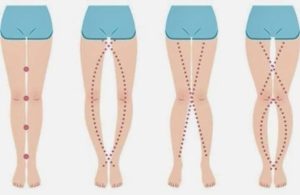WHAT ARE THE FEET OF A WOMAN ABLE TO REFLECT?

1. Type 1 (Far Left) Normal (Straight) Legs: Description
The hips, knees and ankles all line up correctly with the legs.
The distances between the ankles, knees, and thighs are all evident.
What it means:
✅ Shows that bones and joints are in a healthy alignment;
✅ Weight is distributed uniformly, minimising strain on the knees and hips;
✅ Usually doesn’t cause discomfort when standing or walking.
2. Genu Varum Bowlegs — Type 2 (second from left) — Synopsis:
Even when the ankles are together, the knees remain apart.
The legs form a bow-like curvature outward.
What it means: Depending on the severity, it is frequently addressed with physiotherapy or orthotic correction. It can result in knee strain, imbalance, and eventual joint wear and tear. It can be caused by rickets, juvenile bone growth, or adult arthritic problems.
🦵 3. Type 3 (second from right) Knock Knees (Genu Valgum): Synopsis
Ankles remain apart, but knees touch or are quite near together.
Legs seem to bend inward.
What it means: It is frequently observed in children and typically gets better with age.
In adults, it could be a sign of hip issues, flat feet, or joint weakness. Prolonged misalignment can cause arthritis, pain, and instability.
🦵 4. Type 4 (Far Right) Crossed Legs (Extreme Knock Knees or Pelvic Tilt)
Described:
Knees and legs cross over one another quite a bit.
shows a significant imbalance in posture or inward rotation.
What it means: ♠ Possible causes include severe knock knees, posture problems, or pelvic misalignment.
It may necessitate posture adjustment, physical therapy, or a medical evaluation. It may impact hip stability, gait, and pelvic floor health.
🚨 Key Information:
These leg shapes don’t reveal anything about a person’s personality, value, or anatomy.
See a physiotherapist or orthopaedic professional if any of these alignments cause you to feel discomfort, stiffness, or trouble walking.
Alignment can frequently be improved or discomfort can be decreased using exercises, stretches, and corrective footwear.
